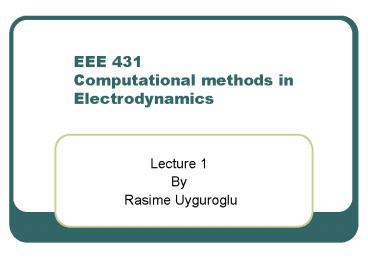EEE 431 Computational methods in Electrodynamics PowerPoint PPT Presentation
Title: EEE 431 Computational methods in Electrodynamics
1
EEE 431Computational methods in Electrodynamics
- Lecture 1
- By
- Rasime Uyguroglu
2
Science knows no country because knowledge
belongs to humanity and is the torch which
illuminates the world.
- Louis Pasteur
3
Methods Used in Solving Field Problems
- Experimental methods
- Analytical Methods
- Numerical Methods
4
Experimental Methods
- Expensive
- Time Consuming
- Sometimes hazardous
- Not flexible in parameter variation
5
Analytical Methods
- Exact solutions
- Difficult to Solve
- Simple canonical problems
- Simple materials and Geometries
6
Numerical Methods
- Approximate Solutions
- Involves analytical simplification to the point
where it is easy to apply it - Complex Real-Life Problems
- Complex Materials and Geometries
7
Applications In Electromagnetics
- Design of Antennas and Circuits
- Simulation of Electromagnetic Scattering and
Diffraction Problems - Simulation of Biological Effects (SAR Specific
Absorption Rate) - Physical Understanding and Education
8
Most Commonly methods used in EM
- Analytical Methods
- Separation of Variables
- Integral Solutions, e.g. Laplace Transforms
9
Most Commonly methods used in EM
- Numerical Methods
- Finite Difference Methods
- Finite Difference Time Domain Method
- Method of Moments
- Finite Element Method
- Method of Lines
- Transmission Line Modeling
10
Numerical Methods (Cont.)
- Above Numerical methods are applied to problems
other than EM problems. i.e. fluid mechanics,
heat transfer and acoustics. - The numerical approach has the advantage of
allowing the work to be done by operators without
a knowledge of high level of mathematics or
physics.
11
Review of Electromagnetic Theory
12
Notations
- E Electric field intensity (V/ m)
- H Magnetic field intensity (A/ m)
- D Electric flux density (C/ m2 )
- B Magnetic flux density (Weber/ m2 )
- J Electric current density (A/ m2 )
- Jc Conduction electric current density (A/ m2 )
- Jd Displacement electric current density(A/m2)
- Volume charge density (C/m3)
13
Historical Background
- Gausss law for electric fields
- Gausss law for magnetic fields
14
Historical Background (cont.)
- Amperes Law
- Faradays law
15
Electrostatic Fields
- Electric field intensity is a conservative field
- Gausss Law
16
Electrostatic Fields
- Electrostatic fields satisfy
- Electric field intensity and electric flux
density vectors are related as - The permittivity is in (F/m) and it is denoted as
17
Electrostatic Potential
- In terms of the electric potential V in volts,
- Or
18
Poissons and Laplaces Equations
- Combining Equations , and Poissons
Equation - When , Laplaces Equation
19
Magnetostatic Fileds
- Amperes Law, which is related to Biot-Savart
Law - Here J is the steady current density.
20
Static Magnetic Fields (Cont.)
- Conservation of magnetic flux or Gausss Law for
magnetic fields
21
Differential Forms
- Amperes Law
- Gausss Law
22
Static Magnetic Fields
- The vector fields B and H are related to each
other through the permeability in (H/m) as
23
Ohms Law
- In a conducting medium with a conductivity
(S/m) J is related to E as
24
Magnetic vector Potential
- The magnetic vector potential A is related to the
magnetic flux density vector as
25
Vector Poissons and Laplaces Equations
- Poissons Equation
- Laplaces Equation, when J0
26
Time Varying Fields
- In this case electric and magnetic fields exists
simultaneously. Two divergence expressions remain
the same but two curl equations need
modifications.
27
Differential Forms of Maxwells
equationsGeneralized Forms
28
Integral Forms
- Gausss law for electric fields
- Gausss law for magnetic fields
29
Integral Forms (Cont.)
- Faradays Law of Induction
- Modified Amperes Law
30
Constitutive Relations
31
Two other fundamental equations
- 1)Lorentz Force Equation
- Where F is the force experienced by a particle
with charge Q moving at a velocity u in an EM
filed.
32
Two other equations (cont.)
- Continuity Equation

